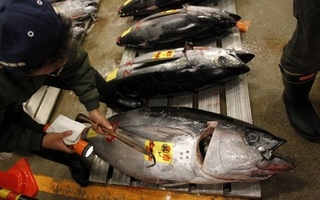 Tuna is the king of sushi, one of the most expensive fish in the world -- and dwindling so rapidly that some fear it could vanish from restaurant menus within a generation.
Tuna is the king of sushi, one of the most expensive fish in the world -- and dwindling so rapidly that some fear it could vanish from restaurant menus within a generation.Yet there is little alarm in Japan, the country that consumes about 80 percent of the world's bluefin tuna. Japanese fisheries experts blame cozy ties between regulators and fishermen and a complacent media for failing to raise public awareness.
"Nobody really knows the bad state bluefin tuna is in," veteran sushi chef Kazuo Nagayama said from his snug, top-end sushi bar in Tokyo's Shimbashi district, a popular area for after-work socializing. "I don't think it'll disappear, but we might not be able to catch any. It's obvious we need to set quotas."
Catching bluefin tuna, called "hon-maguro" here, is a lucrative business. A single full-grown specimen can sell for 2 million yen, or $22,000, at Tokyo's sprawling Tsukiji fish market. Japanese fishermen are vying with Korean, Taiwanese and Mexican counterparts for a piece of a $900 million a year wholesale market.
Fish dealers at Tsukiji market say the number of bluefin sold at early morning auctions has fallen over the past 10 to 15 years, but most are confident the supply will never run out. Sushi bars and supermarkets still readily sell the fish, which is considered a special treat that families might splurge on once every month or two. There's no government campaign to encourage people to rein in their appetites for the iconic Japanese food.
"I have seen some reports on TV about their numbers falling, but I really haven't thought about cutting back on eating hon-maguro," said Sumire Baba, a Tokyo homemaker. "I guess I'm optimistic they'll recover."
A scientific assessment released in January found that Pacific bluefin spawning stocks -- a key measure of adults that can reproduce -- have plummeted by about three-quarters over the past 15 years to match historic lows last seen in the early 1980s. It estimated that the species has dwindled to just 3.6 percent of its original population, and that more than 90 percent of fish caught were juveniles between the ages of 0 and 3, before they reach reproductive maturity.
The report, compiled by the International Scientific Committee for Tuna and Tuna-like Species in the Northern Pacific and based on data through 2010, received only scant coverage in the Japanese press.
The Yomiuri Shimbun, Japan's largest newspaper, ran a brief story that ignored the drop in numbers and focused on a projection offered by the report's authors that Pacific stocks could triple by 2030 if current "effort limits" were fully enforced -- coverage that a senior Fisheries Agency official blasted as "misleading."
News reports earlier this year about the record 155.4 million yen ($1.76 million) auction sale of a Pacific bluefin at the Tsukiji market focused mostly on the exorbitant price and the buyer -- the owner of a sushi chain -- with little context about the species' falling numbers.
The drop follows similar plunges in the other two bluefin species, the Atlantic and the southern, which are now protected by catch quotas that experts say need to be applied to their Pacific cousins as well.
Without stricter caps, "there is a high likelihood that Pacific bluefin will become less available to Japanese consumers," said Masayuki Komatsu, a former senior Fisheries Agency official. Japan faces two choices, he said: Immediately impose catch quotas or "stop eating the bluefin to protect it."
Overfishing of the Atlantic bluefin, much of it shipped to Japan, got so bad that an export ban was proposed in 2010 at a meeting of the 175-nation Convention on International Trade in Endangered Species (CITES). The proposal was rejected, and Atlantic bluefin stocks recovered slightly last year after quotas were imposed, although environmental groups say the population remains fragile.
While the media plays a role, the Fisheries Agency, domestic scientists and fishing industry are mainly responsible for failing to address the problem and keeping the public in the dark, Komatsu and other critics say. During his tenure at the agency until 2005, regulators were often more intent on protecting fishermen than marine resources, he said, and they were also reluctant to publicize information about declining fish stocks or impose catch limits for fear of upsetting fishermen or politicians.
"Government officials don't want to accept the facts," Komatsu said. "Their constituents are fishermen. ... In order to be successful as a government official, you have to listen to the fishermen because they are closely connected to the politicians. It's all very short-sighted."





